IGUANAS
 Blue Iguana |  Albino Iguana |
|---|---|
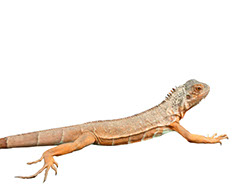 Red Iguana | 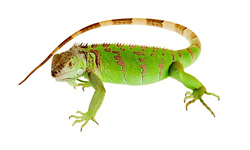 Green Iguana |
Iguana Care Karatasi
Ukubwa: Watu wazima iguanas mbalimbali katika kawaida 4-6 miguu katika urefu.
Urefu wa maisha: Kama vizuri kutunzwa, iguanas wanapaswa kuishi zaidi ya miaka 20 katika utumwa.
Mkuu kuonekana: Iguanas ni nini watu wengi kufikiria wakati wanafikiri 'mjusi.' Wana vidole tano juu ya kila mguu. Wao wamiliki koo nyama ya ngozi chini ya kidevu aitwaye dewlap. Iguanas wote wana miiba kwamba kukimbia urefu wa nyuma. Kinyume na imani maarufu, si iguanas wote ni kijani. Wengi ungfisk ni mkali kijani, lakini umri kama wao na kukua wao unaweza mbalimbali katika rangi kutoka kijani mwanga mdogo na kahawia au hata rangi ya machungwa na mikia milia.
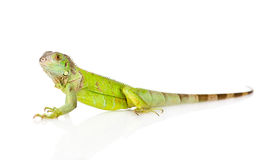
Makazi mahitaji
Ua: enclosure kwa watu wazima iguana ni kubwa sana. Ua lazima miguu angalau sita mrefu, kuhusu 1
Joto: Iguanas wanatoka hali ya hewa ya kitropiki na wanahitaji kuwekwa joto. Joto wa mchana lazima 80.
Joto / Mwanga: Ultraviolet taa kutoa UVA na UVB inahitajika kwa ajili sahihi calcium metaboli na maendeleo ya kiunzi. Bila taa sahihi yako itakuwa wagonjwa na kufa kifo chungu sana. Taa sahihi wanaweza kutolewa kutumia umeme zilizopo hasa kwa ajili ya matumizi ya nyoka kama vile balbu zebaki mvuke kwamba pia kutoa baadhi ya joto pia. Joto ya ziada wanaweza kutolewa kutumia emitters infrared kauri na balbu incandescent basking. Moto miamba kamwe kutumika chini ya hali yoyote ile kama wanaweza ukali kuchoma iguana yako.

Substrate: Iguanas mara nyingi mama lick mazingira yao. Kwa sababu hiyo wengi chembechembe substrate (machujo ya mbao, matandazo, mchanga, au aina ya unga) si sahihi kwa iguanas zaidi. Gazeti kwa wino mashirika yasiyo ya sumu, karatasi mchinjaji, taulo za karatasi, ya ndani / nje carpeting, au nyasi bandia zote kufanya uchaguzi bora. Kama kutumia ndani / nje carpeting au nyasi bandia tafadhali kuwa na uhakika kwamba hakuna masharti dangling ambayo inaweza tangle katika misumari iguana yako. Ni pia ilipendekeza kwamba una vipande mbalimbali ili uweze kuchukua nafasi vipande imechafuliwa na seti safi na kisha safi na disinfect kuweka ya sasa kwa kutumia kwa kuosha ijayo.
Environment: Iguanas come from a tropical climate and require a humidity level of 65% to 75%. To achieve this may require several misting’s a day. Many people opt to purchase an automatic misting system instead.
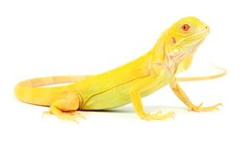
Diet: Iguanas are strict herbivores. Many older literatures will suggest feeding animal protein or even cat food. While some wild iguanas may ingest the occasional insect while eating leaves, it is not a significant portion on their diet. Iguanas that are fed too much animal protein will develop health problems and will die prematurely. A well balanced iguana diet will consist of about 40% to 45% greens (this includes, but is not limited to collard greens, turnip greens, mustard greens, dandelion greens (with flowers), escarole, and/or water cress), 40% to 45% other vegetables (this includes but is not limited to green beans, orange-fleshed squashes (butternut, Kabocha), snap or snow peas, parsnip, asparagus, okra, alfalfa (mature, not sprouts), onions, mushrooms, bell peppers, sweet potato, zucchini, yellow squash, and/or carrots), 10% or less of fruits (including, but not limited to Figs (raw or dried), blackberries, strawberries, raspberries, grapes, mango, melon (cantaloupe, honeydew, watermelon), papaya, banana, and/or apple), and less than 5% of other grains or commercial diets. Iguanas should never be rhubarb as it is toxic. Certain lettuces such as iceberg, romaine, and Boston butter lack sufficient nutrients and should only be fed occasionally. Acidic fruits (citrus, tomatoes, kiwi, pineapples, etc.) should also be only fed occasionally as well. Tofu can be occasionally offered as well for supplemental protein, though if too much is given it can lead to long term health issues. Wild plants and flowers are not recommended since they may be toxic to your iguana or may contain pesticides that could be toxic as well.
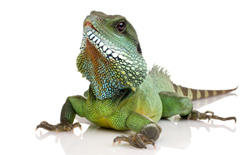
Maintenance: Cleanliness of the enclosure is essential. Waste products should be removed daily and the enclosure should be thoroughly cleaned and disinfected regularly. A 5% bleach solution provides an excellent disinfectant. Be sure to thoroughly rinse the solution from the enclosure before placing the iguana back in. Fresh water should also be offered at all times. Always wash your hands after handling your iguana or any of your iguana\'s cage accessories.